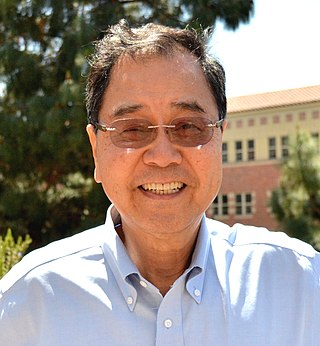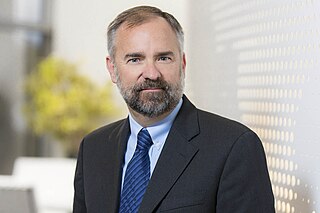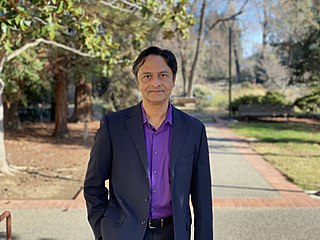Related Research Articles

Electrical engineering is an engineering discipline concerned with the study, design, and application of equipment, devices, and systems which use electricity, electronics, and electromagnetism. It emerged as an identifiable occupation in the latter half of the 19th century after the commercialization of the electric telegraph, the telephone, and electrical power generation, distribution, and use.

An integrated circuit (IC), also known as a microchip, computer chip, or simply chip, is a small electronic device made up of multiple interconnected electronic components such as transistors, resistors, and capacitors. These components are etched onto a small piece of semiconductor material, usually silicon. Integrated circuits are used in a wide range of electronic devices, including computers, smartphones, and televisions, to perform various functions such as processing and storing information. They have greatly impacted the field of electronics by enabling device miniaturization and enhanced functionality.

A fin field-effect transistor (FinFET) is a multigate device, a MOSFET built on a substrate where the gate is placed on two, three, or four sides of the channel or wrapped around the channel, forming a double or even multi gate structure. These devices have been given the generic name "FinFETs" because the source/drain region forms fins on the silicon surface. The FinFET devices have significantly faster switching times and higher current density than planar CMOS technology.
This article details the history of electrical engineering.
Chih-Tang "Tom" Sah is a Chinese-American electronics engineer and condensed matter physicist. He is best known for inventing CMOS logic with Frank Wanlass at Fairchild Semiconductor in 1963. CMOS is used in nearly all modern very large-scale integration (VLSI) semiconductor devices.

Fujio Masuoka is a Japanese engineer, who has worked for Toshiba and Tohoku University, and is currently chief technical officer (CTO) of Unisantis Electronics. He is best known as the inventor of flash memory, including the development of both the NOR flash and NAND flash types in the 1980s. He also invented the first gate-all-around (GAA) MOSFET (GAAFET) transistor, an early non-planar 3D transistor, in 1988.
Chenming Calvin Hu is a Taiwanese-American electronic engineer who specializes in microelectronics. He is TSMC Distinguished Professor Emeritus in the electronic engineering and computer science department of the University of California, Berkeley, in the United States. In 2009, the Institute of Electrical and Electronics Engineers described him as a “microelectronics visionary … whose seminal work on metal-oxide semiconductor MOS reliability and device modeling has had enormous impact on the continued scaling of electronic devices”.
Naoki Yokoyama is a Japanese electrical engineer, active in the fields of nanotechnology and electronic and photonic devices, best known for his success in fabricating hot-electron transistors and invention of resonant-tunneling transistors.

Kang Lung Wang is recognized as the discoverer of chiral Majorana fermions by IUPAP. Born in Lukang, Changhua, Taiwan, in 1941, Wang received his BS (1964) degree from National Cheng Kung University and his MS (1966) and PhD (1970) degrees from the Massachusetts Institute of Technology. In 1970 to 1972 he was the Assistant Professor at MIT. From 1972 to 1979, he worked at the General Electric Corporate Research and Development Center as a physicist/engineer. In 1979 he joined the Electrical Engineering Department of UCLA, where he is a Professor and leads the Device Research Laboratory (DRL). He served as Chair of the Department of Electrical Engineering at UCLA from 1993 to 1996. His research activities include semiconductor nano devices, and nanotechnology; self-assembly growth of quantum structures and cooperative assembly of quantum dot arrays Si-based Molecular Beam Epitaxy, quantum structures and devices; Nano-epitaxy of hetero-structures; Spintronics materials and devices; Electron spin and coherence properties of SiGe and InAs quantum structures for implementation of spin-based quantum information; microwave devices. He was the inventor of strained layer MOSFET, quantum SRAM cell, and band-aligned superlattices. He holds 45 patents and published over 700 papers. He is a passionate teacher and has mentored hundreds of students, including MS and PhD candidates. Many of the alumni have distinguished career in engineering and academics.
This article details the history of electronics engineering. Chambers Twentieth Century Dictionary (1972) defines electronics as "The science and technology of the conduction of electricity in a vacuum, a gas, or a semiconductor, and devices based thereon".
Mark S. Lundstrom is an American electrical engineering researcher, educator, and author. He is known for contributions to the theory, modeling, and understanding of semiconductor devices, especially nanoscale transistors, and as the creator of the nanoHUB, a major online resource for nanotechnology. Lundstrom is Don and Carol Scifres Distinguished Professor of Electrical and Computer Engineering and in 2020 served as Acting Dean of the College of Engineering at Purdue University, in West Lafayette, Indiana.
The IEEE International Electron Devices Meeting (IEDM) is an annual micro- and nanoelectronics conference held each December that serves as a forum for reporting technological breakthroughs in the areas of semiconductor and related device technologies, design, manufacturing, physics, modeling and circuit-device interaction.

Muhammad Mustafa Hussain is an electronics engineer specializing in CMOS technology-enabled low-cost flexible, stretchable and reconfigurable electronic systems. He was a professor in King Abdullah University of Science and Technology and University of California, Berkeley, and is a currently an electrical and computer engineering professor at Purdue University. He is the principal investigator (PI) at Integrated Nanotechnology Laboratory, and Integrated Disruptive Electronic Applications (IDEA) Laboratory. He is also the director of the Virtual Fab: vFabLab™.
Karl Hess is the Swanlund Professor Emeritus in the Department of Electrical and Computer Engineering at the University of Illinois at Urbana–Champaign (UIUC). He helped to establish the Beckman Institute for Advanced Science and Technology at UIUC.

Dr. Gary Patton is an American technologist and business executive. He is currently the Corporate Vice President and General Manager of Design Enablement and Components Research in the Technology Development Group at Intel. He has spent most of his career in IBM, starting in IBM's Research Division and holding management and executive positions in IBM's Microelectronics Division in Technology Development, Design Enablement, Manufacturing, and Business Line Management.

Deji Akinwande is a Nigerian-American professor of Electrical and Computer Engineering with courtesy affiliation with Materials Science at the University of Texas at Austin. He was awarded the Presidential Early Career Award for Scientists and Engineers in 2016 from Barack Obama. He is a Fellow of the American Physical Society, the African Academy of Sciences, the Materials Research Society (MRS), and the IEEE.

Tsu-Jae King Liu is an American academic and engineer who serves as the Dean and the Roy W. Carlson Professor of Engineering at the UC Berkeley College of Engineering.

M. Saif Islam is a Bangladeshi-American engineering professor of Electrical and Computer Engineering at the University of California, Davis.

Supriyo Bandyopadhyay is an Indian-born American electrical engineer, academic and researcher. He is Commonwealth Professor of Electrical and Computer Engineering at Virginia Commonwealth University, where he directs the Quantum Device Laboratory.
Tomás A. Palacios Gutiérrez is a Spanish–American Electrical & Microelectronics Engineer known for his work in advanced device and material design. He holds the chair Clarence J. LeBel Professor of Electrical Engineering and Computer Science at the Massachusetts Institute of Technology and director of Microsystems Technology Laboratories (MTL). Palacios is known for inventing a super-thin 'sheet' that can charge mobile phones with out electricity.
References
- ↑ "Suman Datta — College of Engineering". engineering.nd.edu. Retrieved 2018-10-11.
- 1 2 "Suman Datta". www.ee.psu.edu. Retrieved 2018-10-11.
- ↑ "2013 elevated fellow" (PDF). IEEE Fellows Directory.
- ↑ "IEEE Fellows Directory - Member Profile". services27.ieee.org. Retrieved 2018-10-11.
- ↑ "Search Fellows - National Academy of Inventors". academyofinventors.org. Retrieved 2018-10-11.
- ↑ "Suman Datta - Google Scholar Citations". scholar.google.com. Retrieved 2018-10-11.